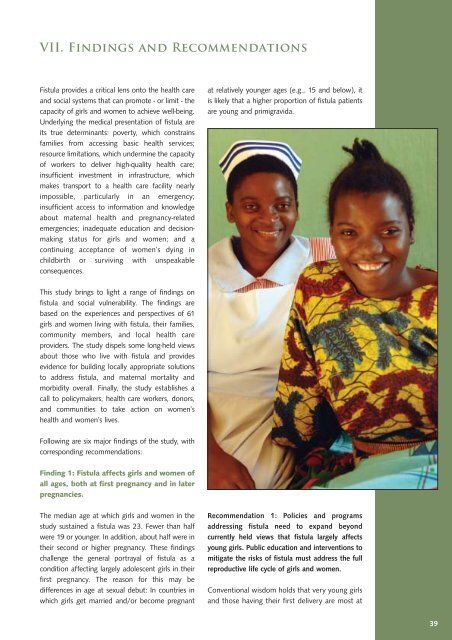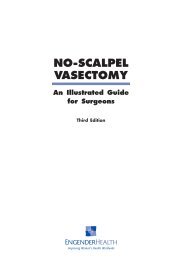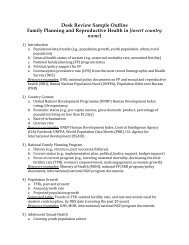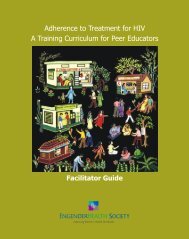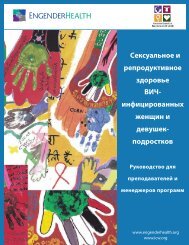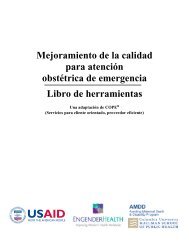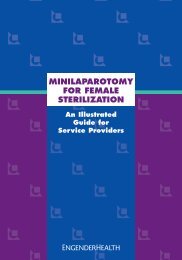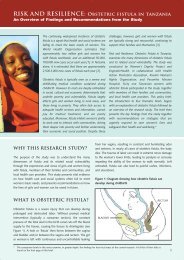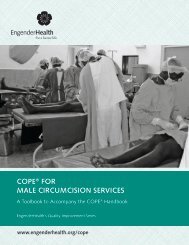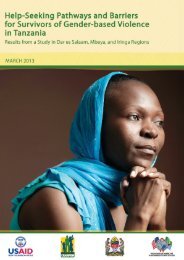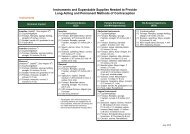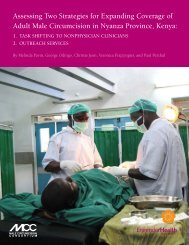Risk and Resilience: Obstetric Fistula in Tanzania - EngenderHealth
Risk and Resilience: Obstetric Fistula in Tanzania - EngenderHealth
Risk and Resilience: Obstetric Fistula in Tanzania - EngenderHealth
You also want an ePaper? Increase the reach of your titles
YUMPU automatically turns print PDFs into web optimized ePapers that Google loves.
VII. F<strong>in</strong>d<strong>in</strong>gs <strong>and</strong> Recommendations<br />
<strong>Fistula</strong> provides a critical lens onto the health care<br />
<strong>and</strong> social systems that can promote - or limit - the<br />
capacity of girls <strong>and</strong> women to achieve well-be<strong>in</strong>g.<br />
Underly<strong>in</strong>g the medical presentation of fistula are<br />
its true determ<strong>in</strong>ants: poverty, which constra<strong>in</strong>s<br />
families from access<strong>in</strong>g basic health services;<br />
resource limitations, which underm<strong>in</strong>e the capacity<br />
of workers to deliver high-quality health care;<br />
<strong>in</strong>sufficient <strong>in</strong>vestment <strong>in</strong> <strong>in</strong>frastructure, which<br />
makes transport to a health care facility nearly<br />
impossible, particularly <strong>in</strong> an emergency;<br />
<strong>in</strong>sufficient access to <strong>in</strong>formation <strong>and</strong> knowledge<br />
about maternal health <strong>and</strong> pregnancy-related<br />
emergencies; <strong>in</strong>adequate education <strong>and</strong> decisionmak<strong>in</strong>g<br />
status for girls <strong>and</strong> women; <strong>and</strong> a<br />
cont<strong>in</strong>u<strong>in</strong>g acceptance of women’s dy<strong>in</strong>g <strong>in</strong><br />
childbirth or surviv<strong>in</strong>g with unspeakable<br />
consequences.<br />
at relatively younger ages (e.g., 15 <strong>and</strong> below), it<br />
is likely that a higher proportion of fistula patients<br />
are young <strong>and</strong> primigravida.<br />
This study br<strong>in</strong>gs to light a range of f<strong>in</strong>d<strong>in</strong>gs on<br />
fistula <strong>and</strong> social vulnerability. The f<strong>in</strong>d<strong>in</strong>gs are<br />
based on the experiences <strong>and</strong> perspectives of 61<br />
girls <strong>and</strong> women liv<strong>in</strong>g with fistula, their families,<br />
community members, <strong>and</strong> local health care<br />
providers. The study dispels some long-held views<br />
about those who live with fistula <strong>and</strong> provides<br />
evidence for build<strong>in</strong>g locally appropriate solutions<br />
to address fistula, <strong>and</strong> maternal mortality <strong>and</strong><br />
morbidity overall. F<strong>in</strong>ally, the study establishes a<br />
call to policymakers, health care workers, donors,<br />
<strong>and</strong> communities to take action on women’s<br />
health <strong>and</strong> women’s lives.<br />
Follow<strong>in</strong>g are six major f<strong>in</strong>d<strong>in</strong>gs of the study, with<br />
correspond<strong>in</strong>g recommendations:<br />
F<strong>in</strong>d<strong>in</strong>g 1: <strong>Fistula</strong> affects girls <strong>and</strong> women of<br />
all ages, both at first pregnancy <strong>and</strong> <strong>in</strong> later<br />
pregnancies.<br />
The median age at which girls <strong>and</strong> women <strong>in</strong> the<br />
study susta<strong>in</strong>ed a fistula was 23. Fewer than half<br />
were 19 or younger. In addition, about half were <strong>in</strong><br />
their second or higher pregnancy. These f<strong>in</strong>d<strong>in</strong>gs<br />
challenge the general portrayal of fistula as a<br />
condition affect<strong>in</strong>g largely adolescent girls <strong>in</strong> their<br />
first pregnancy. The reason for this may be<br />
differences <strong>in</strong> age at sexual debut: In countries <strong>in</strong><br />
which girls get married <strong>and</strong>/or become pregnant<br />
Recommendation 1: Policies <strong>and</strong> programs<br />
address<strong>in</strong>g fistula need to exp<strong>and</strong> beyond<br />
currently held views that fistula largely affects<br />
young girls. Public education <strong>and</strong> <strong>in</strong>terventions to<br />
mitigate the risks of fistula must address the full<br />
reproductive life cycle of girls <strong>and</strong> women.<br />
Conventional wisdom holds that very young girls<br />
<strong>and</strong> those hav<strong>in</strong>g their first delivery are most at<br />
39


